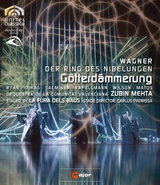I’m back to blogging my way through the La Fura Dels Baus staging of Wagner’s Ring Cycle—I’ve now reached Götterdämmerung, the last of the four operas and the longest (clocking in at 280 minutes).
The structure of Götterdämmerung is slightly different from the two operas that precede it—instead of just three acts, here we get a prologue to begin things. This prologue itself begins with an overture that refers back to the opening notes of the prologue to the entire cycle, Das Rheingold. Similarly, the three Norns, who are daughters of Erda (are who are comparable here to the three Fates of Greek mythology) recall the three Rhinemaidens in the cycle’s opening, who once guarded the gold from which the Ring of the Nibelung was forged.
Here, as in many instances in this staging, the singers are suspended in the air by cables (with helpful signs above their heads in this instance, indicating that they represent the past, present, and future). Between them they hold the rope of Fate, frayed and thick as their wrists, and they retell the story of how Wotan fashioned his spear from a branch of the ash tree Yggdrasil. We find that cutting that single branch led to the slow death of the entire tree, however, and since the events that ended Siegfried, the heroes of Valhalla, at Wotan’s command, have hewn down Yggdrasil and piled the resulting logs at Valhalla’s base. At a propitious time, the logs will be set aflame and the stronghold will be consumed, bringing an end to the reign of the gods.
When this information is at last revealed, the rope of Fate breaks and drops to the floor. Terrified (as, in the rear of the stage, dozens more ropes fall from the ceiling and become randomly tangled together), the Norns descend to their mother Erda, and the scene shifts to Siegfried and Brünnhilde: the ring of fire that barred Siegfried from Brünnhilde in Siegfried has here been cleverly transformed into a circular marriage bed.
Brünnhilde’s transformation from headstrong Valkyrie to devoted and subservient mortal wife is now complete, and she now sends her husband off to do deeds of valor, hoping to gain vicarious honor from his achievements. Armed with the sword Nothung and having proven himself, Siegfried is game for anything. Siegfried’s and Brünnhilde’s professions of love for each other seem sincere, but irony is provided by the rising flames projected on the video screens at the back of the stage. At the end of their duet, doe-eyed Siegfried declares his love by making what must be the most unequal trade in all of opera’s plots—he hands Brünnhilde the all-powerful Ring in exchange for Brünnhilde’s horse Grane, a horse that once could fly (back when Brünnhilde was a Valkyrie) but can no longer. But love is about altruism, not bargaining—though as Siegfried sets off on his journey, the lights on stage go down so that the only thing that can be seen is the Ring on Brünnhilde’s hand (which has its own LED lights within), a symbol of the rejection and corruption of love.
The prologue ends with a musical interlude depicting Siegfried’s journey down the Rhine. Interestingly, in this staging, the general decay of the world of these operas is represented by a change in the appearance of the river itself. While in Das Rheingold, the Rhine (as projected on video screens) was a pure, pristine blue, here it’s polluted with neon-green plastic water bottles that twirl end over end as they are carried by the current. It’s at moments like this when the revisionist staging of the Ring is at its best—modernizing the narrative in a way that’s subtle, humorous and clever, without twisting Wagner’s original meaning or relying too much on imagery that’s lifted wholesale from 20th-century SF movies.
On the other hand, the staging of Act I (which I’ve only watched thirty seconds of at this point) promises to be very, very strange. More on that soon.
Dexter Palmer is the author of The Dream of Perpetual Motion, available from St. Martin’s Press.










